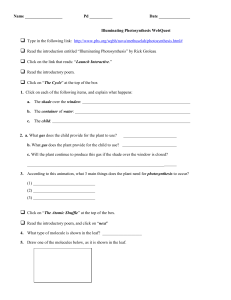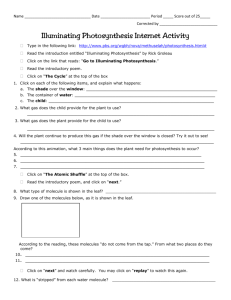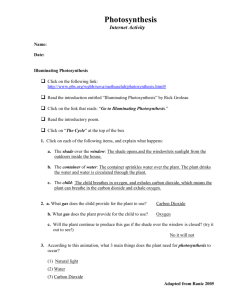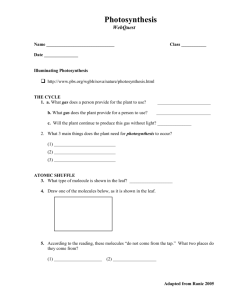Photosynthesis Web Intro
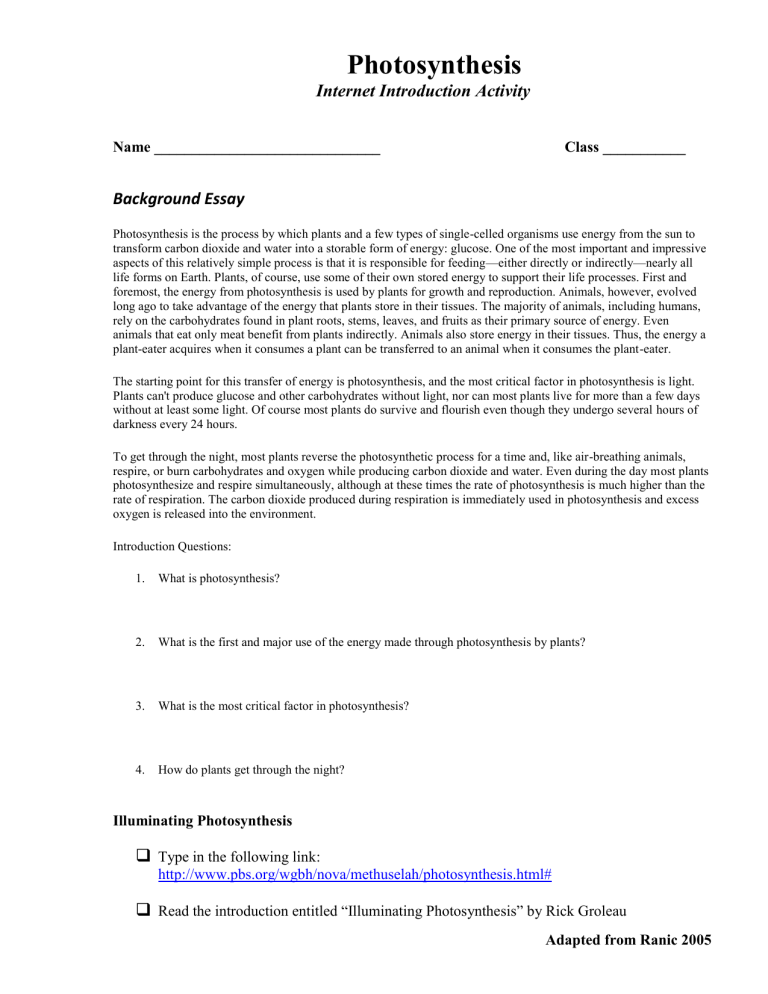
Photosynthesis
Internet Introduction Activity
Name ______________________________ Class ___________
Background Essay
Photosynthesis is the process by which plants and a few types of single-celled organisms use energy from the sun to transform carbon dioxide and water into a storable form of energy: glucose. One of the most important and impressive aspects of this relatively simple process is that it is responsible for feeding—either directly or indirectly—nearly all life forms on Earth. Plants, of course, use some of their own stored energy to support their life processes. First and foremost, the energy from photosynthesis is used by plants for growth and reproduction. Animals, however, evolved long ago to take advantage of the energy that plants store in their tissues. The majority of animals, including humans, rely on the carbohydrates found in plant roots, stems, leaves, and fruits as their primary source of energy. Even animals that eat only meat benefit from plants indirectly. Animals also store energy in their tissues. Thus, the energy a plant-eater acquires when it consumes a plant can be transferred to an animal when it consumes the plant-eater.
The starting point for this transfer of energy is photosynthesis, and the most critical factor in photosynthesis is light.
Plants can't produce glucose and other carbohydrates without light, nor can most plants live for more than a few days without at least some light. Of course most plants do survive and flourish even though they undergo several hours of darkness every 24 hours.
To get through the night, most plants reverse the photosynthetic process for a time and, like air-breathing animals, respire, or burn carbohydrates and oxygen while producing carbon dioxide and water. Even during the day most plants photosynthesize and respire simultaneously, although at these times the rate of photosynthesis is much higher than the rate of respiration. The carbon dioxide produced during respiration is immediately used in photosynthesis and excess oxygen is released into the environment.
Introduction Questions:
1.
What is photosynthesis?
2.
What is the first and major use of the energy made through photosynthesis by plants?
3.
What is the most critical factor in photosynthesis?
4.
How do plants get through the night?
Illuminating Photosynthesis
Type in the following link: http://www.pbs.org/wgbh/nova/methuselah/photosynthesis.html#
Read the introduction entitled “Illuminating Photosynthesis” by Rick Groleau
Adapted from Ranic 2005
Click on the link that reads: “
Go to Illuminating Photosynthesis
.”
Click on “
The Cycle
” at the top of the box
1. Click on each of the following items, and explain what happens: a.
The shade over the window : b.
The container of water : c.
The child :
2. a. What gas does the child provide for the plant to use? b. What gas does the plant provide for the child to use? c. Will the plant continue to produce this gas if the shade over the window is closed? (try it
out to see!)
3.
According to this animation, what 3 main things does the plant need for photosynthesis to occur?
(1)
(2)
(3)
Click on “
The Atomic Shuffle
” at the top of the box.
Read the introductory poem, and click on “ next ”
4.
What type of molecule is shown in the leaf? ___________________
5.
Draw one of the molecules below, as it is shown in the leaf.
6.
According to the reading, these molecules “do not come from the tap.” What two places do they come from?
Adapted from Ranic 2005
(1) (2)
Click on “ next
” and watch carefully. You may click on “ replay
” to watch this again.
7.
a. What is “stripped” from each water molecule?
________ b. From where does the cell get the energy to do this? ____________________ c. The stripped molecules form pairs. Where does it go after this?
Click on “ next ”
8.
a. What gas enters the leaf? _______________________ b.
This gas enters through “holes” in the leaf. What are they called? ________________
Click on “ next
”
9.
What molecule is formed once again ?
Click on “ next
”
10.
Another molecule is formed (“and boy is it sweet”). Draw this molecule below as shown.
Adapted from Ranic 2005
11.
What is the name of this molecule? ________________________________
Click on “
Three Puzzlers
” at the top of the box.
12.
Answer each of the following questions, and explain in your own words . a. Can a tree produce enough oxygen to keep a person alive? Explain. b. Can a plant stay alive without light? c. Can a plant survive without oxygen? Explain.
Adapted from Ranic 2005



